In a groundbreaking development that could revolutionize the field of flexible display technology, a research team at POSTECH (Pohang University of Science and Technology) has pioneered the creation of the world’s first smartphone-type OLED panel capable of dynamic shape transformation while simultaneously functioning as a speaker. This remarkable innovation, led by Professor Su Seok Choi and a talented group of PhD candidates, has been documented in the March online edition of the esteemed journal npj Flexible Electronics. The integration of shape-shifting capabilities with sound generation represents a formidable leap in display technology, promising to reshape user interaction with devices in the years to come.
In the fast-evolving landscape of display technology, flexible screens have emerged as a significant player, poised to redefine how we perceive and interact with electronic devices. Despite their promise, current flexible systems often depend on clunky mechanical components such as hinges and motors to achieve adaptability. While such components facilitate bending, they contribute additional weight, bulkiness, and complexity—which can be particularly detrimental in applications like smartphones where sleekness and portability are paramount. The POSTECH team set out to address these limitations, providing a solution that retains the slender, lightweight profiles characterized by OLED displays while introducing transformative functionalities.
Historically, the deployment of different structural mechanisms has created a barrier to achieving the seamless integration of flexibility and sound without compromising device design. Conventional methods for achieving immersion in the display experience often necessitate separate speaker systems, which further complicate device architecture. By conceptualizing a design paradigm where both audio and visual functionalities are encapsulated in one compact form, POSTECH researchers have broken new ground that eliminates the need for bulky external speaker modules.
At the core of their innovative design is a sophisticated ultra-thin piezoelectric polymer actuator. This device ingeniously facilitates shape transformation via electrical signals, allowing the OLED panel to morph into a spectrum of intricate geometries—not limited to simple curves, but also emanating S-shaped or wave-like forms that can respond dynamically to user interaction. Without relying on traditional mechanical elements, this technology enhances the fluidity and versatility of the display, offering a level of freedom and efficiency that has previously eluded manufacturers.
The ability of this actuator to generate sound further amplifies its significance. Conventional speaker systems invariably add weight and complexity; however, with POSTECH’s technology, the display surface itself can emit sound. This dual-function capability fundamentally alters the user experience by creating an immersive audio-visual interface while simultaneously minimizing the physical profile of the device. Users can now enjoy multimedia content produced directly from the screen, thereby enhancing engagement and interaction without the clutter of additional components.
During experimentation, the research team successfully demonstrated their concept on a smartphone-scale OLED panel, achieving dependable and reversible shape transformations alongside the clear sound output. This implementation unveiled a compact and adaptable design that holds promise for various applications, from mobile devices to wearables, and could potentially transform industries reliant on display technology. As competitive products continue to prioritize mechanical solutions, POSTECH’s fully integrated approach starkly contrasts with existing offerings, establishing a new benchmark in the field of OLED innovation.
Current players in the display industry, such as LG and Samsung, often incorporate different mechanical supports for bendable designs while sacrificing communicative properties. When weighed against POSTECH’s innovative OLED design, their products seem to lead users toward undesirable compromises; thus, the POSTECH technology emerges not just as a novel idea, but as a fully-realized potential that could herald a new era for consumer electronics.
Moreover, the implications extend beyond mere technological excitement; they speak to potential advancements in user-centric design and interaction. The integration of form and function poses exciting prospects for devices not just in smartphones but in automotive interfaces, smart homes, augmented realities, and even soft robotics—broadly suggesting a future where devices actively respond to user needs.
This leap into the future of user experience is also supported by significant collaboration and funding from Korea’s Ministry of Trade, Industry, and Energy, the LG Display–POSTECH Incubation Collaboration Project, as well as the National Research Foundation of Korea. Their involvement underscores the importance and potential impact of such research in driving technological advancements in the field, indicating that as the demand for intelligent devices grows, the fundamental solutions must evolve as well.
As POSTECH’s work highlights, the synergy of shape adaptability and sound emission not only fosters creative applications but also emphasizes the importance of developing technologies that prioritize user experience above traditional design constraints. This will no doubt encourage innovators within the industry to consider other integrations that make devices simpler, more efficient, and increasingly sophisticated.
The ramifications of this study extend far beyond the realm of entertainment devices; they herald the advent of sophisticated, responsive technologies that can reshape our relationships with devices. The fluidity of interaction that allows users to adapt their interfaces and sound systems in real time could result in a new dimension of engagement that transforms everything we know about how we connect with electronic platforms.
In conclusion, POSTECH’s innovative OLED panel that merges shape transformation with sound integration represents a remarkable leap forward in display technology. It sets the stage for the next wave of responsive, adaptive, and user-friendly devices that have the potential to change how we consume media, interact with technology, and engage with our environments. This pioneering work builds the groundwork for a future where intelligent displays not only respond to our visual preferences but also to auditory demands, ensuring that technology not only keeps pace with user expectations but enhances them in unprecedented ways.
Subject of Research: Shape transformation and sound integration in OLED displays
Article Title: Dynamic bendable display with sound integration using asymmetric strain control of actuators with flexible OLED
News Publication Date: 12-Mar-2025
Web References: http://dx.doi.org/10.1038/s41528-025-00396-6
References: npj Flexible Electronics
Image Credits: POSTECH
Keywords: OLED technology, flexible displays, sound integration, smartphone innovation, actuation mechanisms, user interaction, multimedia interfaces, device design, acoustic properties, advanced electronics, responsive displays, soft robotics.




